
An interesting account of the above was published in Coin News & Format (48, 49 or 50)
These are now common - I was told a dealer in Dublin had bought a "carrier bag full"
(I need to check the size of these sometime)
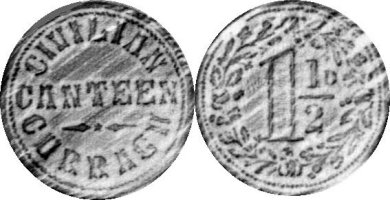
rubbing courtesy C. Denton
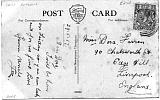
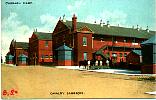
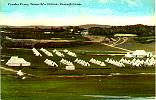
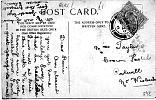
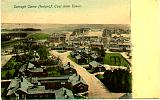
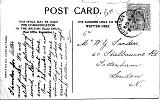
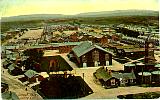
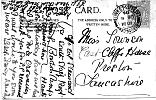
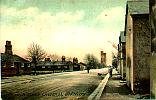
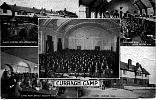
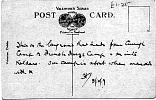
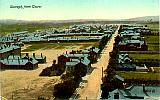
| HOME | IRISH TOKENS | Copyright © S.B.Woodside 1997-2008 Last update:- 12-July-08 barry.woodside@ic24.net |
| Military & Internment Camp | ||
| Scroll through the data or use the shortcut index below. | ||
br=brass, bz=bronze, Cu=copper, Sn=tin, Al=aluminium, Zn=zinc
"|" stands for
a line break. If this is in the outer legend, it indicates the
lettering is "upside down" with respect to the earlier lettering
"=" indicates the following data is in the field
I have those marked with an asterisk.
Items illustrated without "*" are from rubbings or photocopies.
If you can supply any missing illustrations, please do so.
An excellent illustrated listing of all known British Regimental tokens
together with background details has been published by John F. Yarwood.
With thanks to
Ian Whyte, Stephen Byrne, Frances & Howard Simmons,
Jeff Gardiner, John F. Yarwood and Michael Knight
for supplying some of the illustrations.
| GS116.1 | ATHLONE countermarked on coins | |
| Gavin Scott, suggests these might have been some form of military store check. | ||
| -- | ARMAGH c/m on coins (military as previous?) | |

| ||
| *IN1-89 | CURRAGH 1940 = 1d 30mm uni br (the centre raised) see IN58 | |
| blank | ||
| *IN1-89 | do. = 6d 28mm uni br | |
| *IN1-89 | do. = 1/- 30mm uni Al | |
| *IN1-89 | do. = 2/- 28mm uni Al | |
| Used by Allied & Axis "POWs" (in neutral Rep. of Ire) during WW2 An interesting account of the above was published in Coin News & Format (48, 49 or 50) These are now common - I was told a dealer in Dublin had bought a "carrier bag full" (I need to check the size of these sometime) | ||
 rubbing courtesy C. Denton | ||
| IN1-89 | CIVILIAN CANTEEN CURRAGH | |
| 1½d in wreath 23mm br | ||
| IN2-86 | CURRAGH paper exists? | |
There are a number of pictures of the camp (mostly pre WWI).











| ||
| IN2-86 | BALLYKINLAR CAMP 1d TOKEN (official) black on blue (IN81) | ||||||||
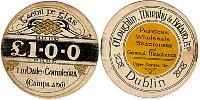
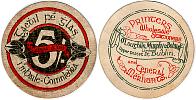
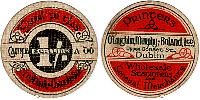
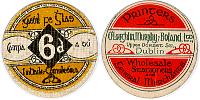
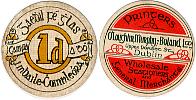 Images courtesy Gary Oddie IN2-86
|
| PRINTERS O'LOUGHLIN, MURPHY & BOLAND Ltd UPPER DORSET ST DUBLIN | WHOLESALE STATIONERS AND GENERAL MERCHANTS (unofficial) various wording £1, 10/=, 5/=, 2/6, 1/=, 6, 3, 1d
| see IN3-86,IN57,67,73 | Many of these were illustrated in the magazines. 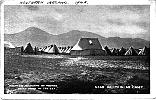
 a postcard "Near Ballykinlar Camp"
a postcard "Near Ballykinlar Camp"More details might be contained in the following papers;- The University College Dublin has papers, ref IE UCDAD P53 Papers of Michael Hayes (1889-1976) covers the period 1906-72 Born in Dublin and educated at the Christian Brothers School, Synge Street and University College Dublin where he graduated in Irish, English and French. He taught at his old school for several years before returning to U.C.D. as an assistant in French in 1912. He joined the Irish Volunteers in 1913 and fought with Thomas MacDonagh in Jacob's Factory [SBW note: another token issuer!] during Easter Week 1916 after which he was interned in Frongoch. An active member of Sinn Féin, Hayes' [sic] house was raided in November 1920 while Richard Mulcahy, Chief of Staff of the I.R.A. was hiding there. Mulcahy escaped but Hayes was arrested and interned in Ballykinlar where he was Director of Education. Later elected to the Second Dáil, he was released in August 1921, supported the Treaty and served as Minister for Education in the Dáil Cabinet, January-September 1922. He was elected Ceann Comhairle [Speaker] in September and held the office until 1932. He lost his seat in the 1932 general election. He also served as Chairman of the Civil Service Commission, 1923-32. Hayes was appointed Lecturer in Modern Irish Language and Literature in 1932 and Professor in 1951. He sat in Seanad Éireann from 1932 until 1965 and was a member of the Governing Body of U.C.D. and of the Senate of the National University of Ireland. Ballykinlar No 2 Internment Camp (1921): correspondence and reports concerning educational activities in the camp; correspondence with family and friends while interned and other internees after his release; draft chapters of a book describing conditions and activities in the camp. | ||||
| IN2-86 | SPIKE ISLAND paper exist? | |
| IN67 | BIRR GARRISON CANTEEN ¼d | |
| br (&IN68) | ||
| IN67 | do. but ½d | |
| same pewter/Zn (& Whytes) | ||
| IN67 | do. but 1d | |
| round pewter? (&IN68) | ||
| Ad- | do. but 1d | |
| same round br | ||
| IN67 | do. but 3d | |
| triangular | ||
| IN67 | do. but 4d | |
| sq., | ||
| IN67 | do. but 6d | |
| oct pewter? (IN68) | ||
| Six were illustrated in IN67 - ¼d, ½d, 1d, 3d, 4d & 6d. In IN68, F.E.Dixon reported obtaining 3 c1950. He went on to suggest they were used late 19th C. Birr became Parsonstown in 1790 but reverted to Birr 1906, although the military reverted in 1860. John Yarwood writes;- Units of the Royal Artillery were named as Garrison units between 1877-1882 and then in 1889 Garrison units were renamed, so these tokens had to be made between 1877 and 1889 if issued by the RA. | ||
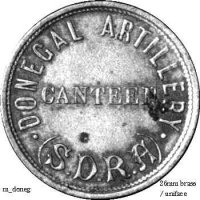
| ||
| *-- | DONEGAL ARTILLERY | .(S.D.R.A). = CANTEEN | |
| blank 26mm br | ||
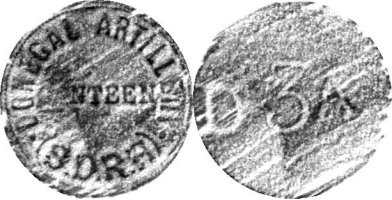
courtesy Jeff Gardiner | ||
| -- | as previous | |
| stamped D 3A | ||
| The following info courtesy John Yarwood; Donegal Artillery Canteen token - SDRA is Southern Division Royal Artillery. Four companies of militia were detached to form the Donegal Artillery in 1854. Disbanded in 1909 as the Donegal Royal Field Reserve Artillery. | ||
| Ad-- | RATH CAMP A DIA SAOR EIRE around 1921 c/m on UK 1/2d (S Byrne) | |
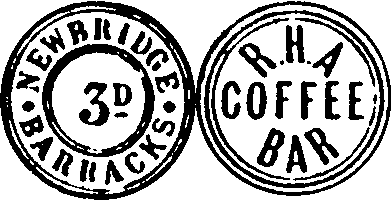
Image courtesy Michael Knight | ||
| -- | NEWBRIDGE | .BARRACKS. = 3d | |
| R.H.A | COFFEE | BAR 31mm br | ||

Image courtesy Michael Knight | ||
| *-- | NEWBRIDGE | .BARRACKS. = 1d | |
| R.H.A | COFFEE | BAR 28.5mm Cu plain edge | ||


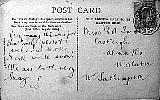
The following information courtesy John Yarwood; The Newbridge Barracks token was issued by the Royal Horse Artillery. By the end of the year I should have at least 2 books about the Royal Artillery, at least 1 is on the way to me by seamail. The temperance movement became very strong in the latter half of the 19th century and with Methodism had a strong influence in trying to wean the soldier from alcohol. Every regiment in the 1890's had its "coffee shop" or Regimental Institute where non alcoholic beverages were served. The following was found on the www. The Military Barracks | ||
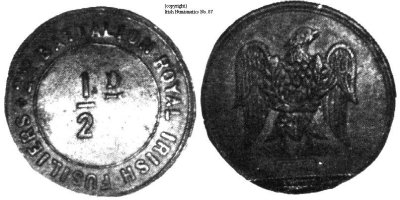
see IN87 | ||
| IN87 | ROYAL IRISH FUSILIERS * 2ND BATTALION = ½d in a circle | |
| (Regimental badge (?)- an eagle, poss. something in exergue) | ||
 Image courtesy Frances & Howard Simmons, Simmons Gallery see www.simmonsgallery.co.uk | ||
| -- | ROYAL IRISH FUSILIERS * 2ND BATTALION = 6d in a circle | |
| an eagle 33.5mm Zn milled edge | ||
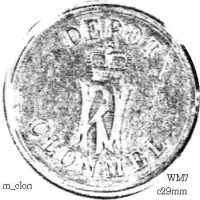
Image, courtesy S.Byrne | ||
| Why97 | DEPOT | CLONMEL = crowned ornate RI | |
| 1d 28mm (Royal Irish?) | ||
|
The folling courtesy of John Yarwood Probably the first garrison of Clonmel was the men commanded by Hugh Dubh O'Neill, who defended the town against Oliver Cromwell in 1650. However even before that date the town was enclosed by a Medieval wall, parts of which still stand today to the north of St. Mary's Church in Mary street. The base of a tower can also be seen in the entrance hall of the cinema in Kickham St. The West gate as Clonmel people know it today is a restoration on the site of the original which dates from 1826. It is thought that a castle stood on the site occupied by the O'Connell Mall in the 13th century. O'Neill's men were native Irish from Ulster and were billeted in houses in the town. The Anglo-Norman townspeople were less than happy to support two regiments of troops along with their camp followers. They made such a nuisance of themselves that the mayor, John White, wrote to the Earl of Ormonde asking him to remove as many as he could. After the fall of the town in May 1650, Clonmel was garrisoned until 1922 by the British army. The first garrison was in the Franciscan Friary which was then in more or less the same location as at present, though it's grounds were bigger, extending further north and west to Mitchell St and Sarsfield St. The building that is still called the Main Guard, is so called because the town guard was situated there in those days, in the centre of the town. In later years it was the residence of the town hangman, convenient to the jail which stood on the site of Larkins hotel. In recent years 23 skeletons were unearthed behind the town hall during building work. This area is approximately 100m east of the old fort. The remains were dated to the late 1600s and are thought to have died in a skirmish as several had evidence of gunshot wounds. Before 1704 two horse barracks were built to the north of Mitchell St. They were small and fell into disrepair. In 1769 Major General Richard Peison reported that the 9th Regiment of Dragoons occupied Clonmel, with a troop in Thurles and another in Fethard. The barracks were in bad condition with rain penetrating in many places. One barrack wall was about to collapse and the yard was too small to contain forage and dung. A squadron of soldiers was living in a straw hut big enough to hold a troop. Conditions apparently got the better of a soldier known only as Gerard of his Majesty's cavalry who departed this life on 26 April 1714 and now rests in St. Mary's graveyard. VICTORIA BARRACKS An infantry barracks was built in 1780 on a green west of the town on the site where the main part of Kickham barracks now stands. After the American revolution, unrest in Ireland and the ever-Present threat from France, it was thought wise to fortify the country. Barracks were built in practically every Irish town. Twenty five years later an artillery barracks was built adjoining and to the west of the old barracks. The magazine and surrounding buildings, including the current barrack museum date from this period. A stone inscribed with the date 1805 is inset high on the east wall of the magazine. This is the oldest building standing in the barracks today. In 1859 a further inspection on the barracks of Ireland painted a bleak picture of a soldier's life. At this time the Infantry barracks consisted of one large building in the middle of the square and several detached houses . The main building was three stories high with stone stairs leading onto a corridor on each storey. The windows faced south. 230 men were accomodated in 22 rooms here. It was calculated that there was room for 335 men in the barracks which accomodated 476. There were no married quarters which was bad news for the 28 women who lived with their husbands in the men's rooms. Light was supplied by candles, heat by old stoves and water by hand pumps. The latrines were unlit, unventilated and drained into cess pits. The Artillery barracks was a little better off. Here 161 men lived where there was accomodation for 106. However 18 men lived over the canteen and were plagued with tobbacco smoke and beer fumes. A further 20 lived in a straw store. The barrack hospital was overcrowded and in the same condition as the barrack rooms. It was also located near the stables which can only have added to the general air of hygiene. As a result of this report the barracks were largely rebuilt and enlarged. Only the garrison church, built in 1856 and the magazine, which I mentioned previously remain from before the 1870s when the canteen, officers mess and married quarters were built. The married quarters, built in 1878 still stand to the north of the barracks. They were used, until recently, by Clonmel Corporation as flats. A hospital, built between the married quarters and the barracks was demolished in the 1950s as was the large accomodation block which stood where the green opposite the west gate is now located. Conditions in the barracks took their toll on the inhabitants as witnessed by the headstone inscriptions in the town cemeteries. The unfortunate surgeon of the 66th foot, Robert Coombs buried his six week old son and 18 year old wife, Margaret in the space of six weeks in 1806. Until 1882,a large variety of units passed through Clonmel. During the Napoleonic wars they were largely militia units, such as the Armagh and North Cork militias. The regular Regiments were needed for the wars in Spain and elsewhere. After the defeat of Napoleon in 1815, the soldiers returned to their peacetime occupations of chasing poteen makers through the countryside. The writer, George Borrow, as a 13 year old, accompanied his father Capt. Thomas Borrow of the Norfolk Regt to the town at this time. In 1826 Lt. Fredrick Close of the 86th foot fell in love with a local girl, Anna Grubb, daughter of a well-to-do quaker merchant. The affair was frowned upon by the girls family. On the evening of 26th February Anna arranged to meet her lover by the Gashouse bridge. The two lovers went for a stroll along the river Which was in flood. They were never seen alive again. At first it was Thought the couple had eloped. It was treated as a bit of a joke in the regiment, the Adjutant even ordered the band to play the tune "Merrily Danced the Quakers wife" at tattoo one evening. However a month later two boatmen pulled the body of Lt. Close from the river at Kilganey, two miles from the town. Anna's body was found later after a search. The coroner's verdict was suicide. However it was alleged in a newspaper that the pair had been murdered by a rival suitor. The ensuing libel case was won by the plaintiff. Lt. Close is buried in St. Mary's church yard. Anna is buried in an unmarked grave in the Friends burial ground in O' Neill St. Romantically, his ghost is said to regularly make the short journey from one burial ground to the other to visit his lost love. After 1882,due to army reforms, Clonmel barracks, renamed Victoria barracks in 1837 in honour of Queen Victoria's coronation, became the regimental depot of the Royal Irish Regiment. The oak and walnut trees at the south wall of the infantry barracks were planted at this time to mark the occasion. The regiment recruited from counties Tipperary, Waterford, Wexford, Kilkenny and Carlow. The recruits were trained in Clonmel until the Great War and after and shipped off to wherever the battalions of the regiment were stationed. More than 50 members of the regiment from Clonmel town alone were killed in the First world war. During the War of Independence and the Civil war Clonmel was in the thick of things again. The 5th Bn, South Tipp Bde of the IRA had a strength of 420 men, though how many were effective is anyone's guess. Opposing them were the men of the Devonshire Regt and from mid-1921, the York & Lancs Regt. On 5th Feb 1922 the barracks was taken over from the British army by the 5th Bn, IRA. under the command of Comdt. Paddy Dalton. He, along with most of his men took the anti treaty side in the ensuing civil war. In August 1922 the pro-treaty forces advanced from Waterford via Carrick-on-Suir to capture Clonmel. The barracks was occupied by the 25th Bn of the National Army until the end of the Civil war. During this time a guerrilla campaign was waged in the area of the town. The barracks was handed over to the Office of Public Works in 1927 And not reoccupied until 1941 when it was taken over by the Field Engineers of the 1st Bde. The Grammar school in Irishtown and the old Jail were occupied and used as barracks for the duration of the war. The old jail was renamed Emmet barracks. After the emergency the 13th Bn Remained in occupation until 1956 when it was disbanded and B and SP Companies of the 12th Bn took over. | ||
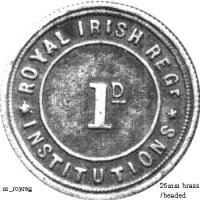
REGt or REGr? | ||
| *-- | ROYAL IRISH REGt | *INSTITUTIONS* = 1d | |
| beaded blank 25mm br | ||
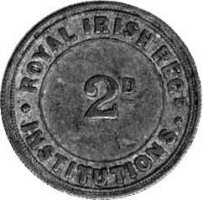
| ||
| *-- | ROYAL IRISH REGt INSTITUTIONS = 2d | |
| beaded blank 30.2mm br (Listed Simmons Gallery Mailbid 22.) Seen elsewhere described as 32mm brass. | ||
|
The following from John Yarwood;- 1684 raised in Ireland from independent companies of pikemen regimented as the Earl of Granard's regt of Foot., Redesignated 1695 as the Royal Regt of Ireland. Underwent various name changes and even served as marines 1717-18 and 1797. 1751 numbered 18th Regt of foot, 1881 designated as the Royal Irish Regiment. 1922 disbanded. An article on The Royal Irish Regiment appeared in the British Numismatic Journal BNJ No 12 1916, pp.251-257 C. WINTER, The Royal Irish Regiment - presumably tokens or perhaps medals were listed. He also wrote of Relics of Lieutenant-Colonel Thomas Lloyd of the Ninety-Fourth Regiment (now the Second Battalion the Connaught Rangers) pp.241-246 in the same issue. | ||
| Why98 | WARLEY CAMP inscribed on edge of DH351 (grate/mAY IRELAND ..) lot 532 | |
| (This might be an English Camp.) | ||
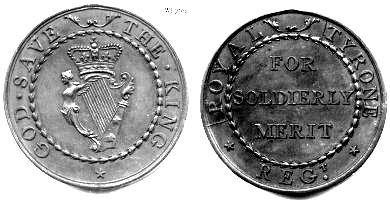
Image courtesy Ian Whyte | ||
| Whytes | ROYAL TYRONE * REGt * = FOR SOLDIERLY MERIT | |
| GOD SAVE THE KING = crowned harp | ||
This was listed by Frazer, under Mossop, on pages 452 and 453 as follows;-TYRONE REGIMENT. - FOR SOLDIERY MERIT, and outside a wreath, ROYAL TYRONE REGIMENT. Reverse. - A harp and royal crown, GOD SAVE THE KING. Size, 1.6. Struck in bronze and silver. This medal has not Mossop's name. Mr Woodhouse possesses the dies, which were evidently made in haste, the stars on the harp being double struck; and it also became cracked soon after completion. The medal is reported to have been fabricated in 1797, and given by the colonel to soldiers of this regiment.Note Frazer says REGIMENT whereas the above illustration shows REGT | ||
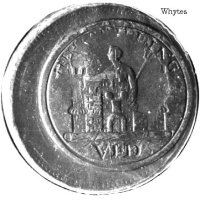
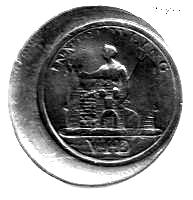
Both illustrations courtesy Ian Whyte | ||
| GS90.1 | INNISKILLING VI*D (6th Dragoons?) c/s on 1/2d 1806 | |
| I have illustrated this twice - different detail is visible in each. Some buttons;- 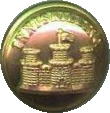
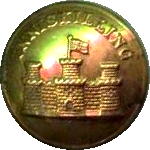
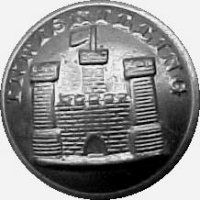 Scott has suggested these "tokens" might have been made from button dies. A couple of postcards;- 
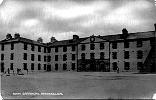  shoulder badge of the 6th Dragoons - later 6DG was used -www shoulder badge of the 6th Dragoons - later 6DG was used -www
The following information courtesy John Yarwood; Inniskilling V1 D = the 6th (Inniskilling) Dragoons. Raised in 1689 as Sir Albert Cunningham's Regt of Dragoons. Known until 1751 by the name of the colonels. Ranked 1690 as 7th of dragoons; reranked 1691 as 6th. Known also ca 1715 as the Black Dragoons. Designated 1751 as 6th (Inniskilling) Dragoons. Redesignated 1921 as The Inniskillings (6th Dragoons). The token itself reminds me of the design of the copper tokens issued 1789-1804. | ||
| (various) | ||
| The following lot was in Whytes Sept 98 catalogue (lot 842). Northern Ireland Military: officers' mess tokens inc. G Warwick 5s (2) & 10s (2), booklets of 1d, 2d, 3d tokens R.A.F. Nutts Corner (airfield) 1 booklet of penny tokens, a range of NAFFI coupons inc. chocolate and cigarettes, RAF Killadeas officers' mess cash books (2), mainly printers proofs (19 items) | ||
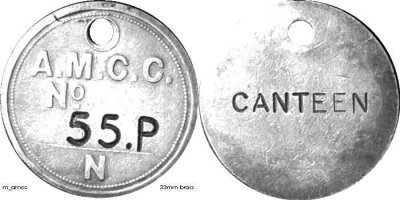
| ||
| *-- | A.M.C.C. | No | 55.P (stamped) | ...... | N | |
| CANTEEN (stamped) 33mm br | ||
| It was suggest to me that this might be a military piece. I bought it in Dublin, but it might not be Irish nor Military. CC could stand for Catering Corp, Cricket Club, County Council, Canal Carriers etc. | ||
| (Royal Munster Fusiliers?) | ||
| MF | ||
| crossed swords VINDICAT ATQUE POLIT. | ||
| The following from John Yarwood; There is a token which it has been suggested was issued by the Royal Munster Fusiliers. Brass, round 23mm Does this sound like a Munster Fusilier token? The motto is not that of the Munster Fusiliers as far as I can tell. I previously saw this advertised as "Irish?" in Format I think but wasn't convinced. I asked some "military" collectors at the Dublin Coin Fair but they suggested it might be German. | ||
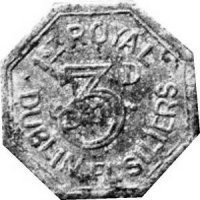
| ||
| 1ST ROYAL DUBLIN FUSILIERS = 3D | ||
| "same both sides" | ||
| 33mm brass IRISH BATTALIONS - ROYAL DUBLIN FUSILIERS The Royal Dublin Fusiliers actually originated in India! In the mid-1600s, the East India Company established a garrison, Fort St. George, to protect one of their factories. They recruited 50 men, the kernel of the Madras European Regiment. Before 1700, 500 Irishmen were soldiers with the Company. The regiment became the 102nd Royal Madras Fusiliers. Following the Indian Mutiny of 1857, the Crown took over the East India Company's army and the Royal Madras Fusiliers merged with the Bombay Corps (nicknamed The Old Toughs, because of its hardened soldiers) forming the Royal Dublin Fusiliers. The regimental depot was at Naas, Co. Kildare. Inspection of the Royal Dublin Fusiliers by H.R.M. the Duke of Connaught, 17th August, 1907. The Boer War brought the 2nd Royal Dublin Fusiliers' first victory, though at a high cost. In November 1899, a party of Dubs was taken prisoner by the Boers. A London Evening Post journalist accompanying them, Winston Churchill, was also imprisoned, but escaped after two months. He telegraphed their Colonel "My earnest congratulations on the honour of the Dublin Fusiliers more than any other Regiment have won for the land of their birth. We are all wearing the Shamrock here." | ||
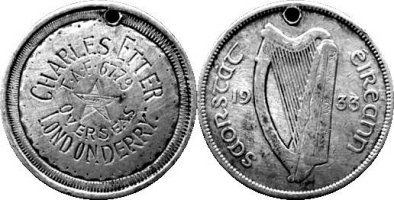
| ||
| CHARLES ETTER | T.A.F. 6779 | a 5 pointed star | OVERSEAS | LONDONDERRY all engraved (?) on the obverse of an Eire florin dated 1933. | ||
| normal florin reverse | ||
| A countermarked Irish florin. Apparently Charles Etter was a member of the USA's Tactical Air Force based in Londonderry during WWII. A large number of USA personnel were based around Lough Foyle, on Fleet Protection duties - L. Foyle was at or near the extreme range for the German bombers. I guess 6779 was his squadron number. | ||

| ||
| IT14 | . ROYAL ULSTER RIFLES . | 2ND BATT = 8 As. | H.F.S. | 1924 | |
| an Urdu inscription in Persian characters which translates as;- Hajji Shihab (al) Din | 881 (all struck incuse) brass 28mm | ||
| IT15 | As previous but 4As | |
| As prev. but with numerals 205, brass 24mm | ||
 | ||
| IT-- | . ROYAL ULSTER RIFLES . | 2ND BATTION = 4 As. | 1926 | |
| T | H.F.S. ( T Haji F. Shabodeen ) brass 28.5mm | ||

| ||
| .ROYAL ULSTER RIFLES. 2ND BATTALION = VALUE | OF GOODS | 5. Rs. | 1926 | ||
| T | H.F.S. brass 30mm | ||
| .ROYAL ULSTER RIFLES. 2ND BATTALION = 8 As. | H.F.S. | 1924 | ||
| In the centre Haji Shihab din - written in Persian with 881 below brass 27.7mm | ||

| ||
| .ROYAL ULSTER RIFLES. 2ND BATTALION = 16 As. | H.F.S. | 1924 | ||
| In the centre Haji Shihab din - written in Persian with 2040 below brass 30mm | ||
| The RUR moved to India in 1923/4 and remained until 1931. Hajji Shihab Din was a contractor to the regiment from 1924-1931 and Battalion when they went to India in 1937. He was known to the English soldiers as Haji F Shabodeen and the initials HFS are on the token. | ||
 Courtesy John Yarwood Courtesy John Yarwood | ||
| CT-; | IRISH REGIMENT OF CANADA = LUCK OF THE IRISH | crowned harp | |
| ? | ||
| - | ||
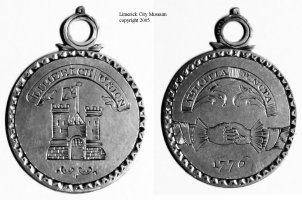 Courtesy Larry Walsh, Curator Limerick City Museum © 2005 | ||
end of data